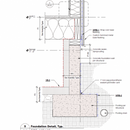Insulation and Air/Vapor Barrier in a Conditioned Crawlspace
We’re building a single story home in Portland OR, CZ 4C. The house will have a conditioned crawlspace, which the architect detailed in the attached sketch.
Based on some comments I got on GBA in other posts, I had some additional questions regarding this design:
1. Given that the house has a conditioned and insulated crawlspace, it appears that the underfloor fluffy insulation is not necessary. I think that the architect made a cut/paste error here, because “F1” Assembly Type that is called out is actually for unconditioned crawlspace, not conditioned. But before I reach out to the architect, I’d like to get a confirmation that the fluffy is not needed in this situation?
2. Without the fluffy (or even with), there does not appear to be appropriate rim joist insulation. Given that we’re in a mild climate and the crawlspace is conditioned, what should we specify for the rim joist – spray foam, rigid, etc?
3. As I mentioned in another post, we may add a patio along the back side of the house at close to interior floor level. That would put the patio near the top of the rim joist. I’ve seen two approaches recommended – seal the outside concrete/rim joist with SAM and cover with flashing (i.e. allow rim joist to dry to inside), or extend vapor permeable barrier (WRB-1 in sketch) and siding on outside down to foundation level, and add a drain and an air gap on the outside between the stemwall and the patio (i.e. allow rim joist to dry to outside). To me it seems like sealing the outside with SAM and flashing, and drying the rim joist to the inside, is easier than the other way. What do you all think?
4. Lastly, a couple of questions about the crawlspace vapor barrier. Does it matter if it’s on the inside or outside of the rigid? And does it need to go all the way up to the subfloor on the inside of the rim joist?
GBA Detail Library
A collection of one thousand construction details organized by climate and house part










Replies